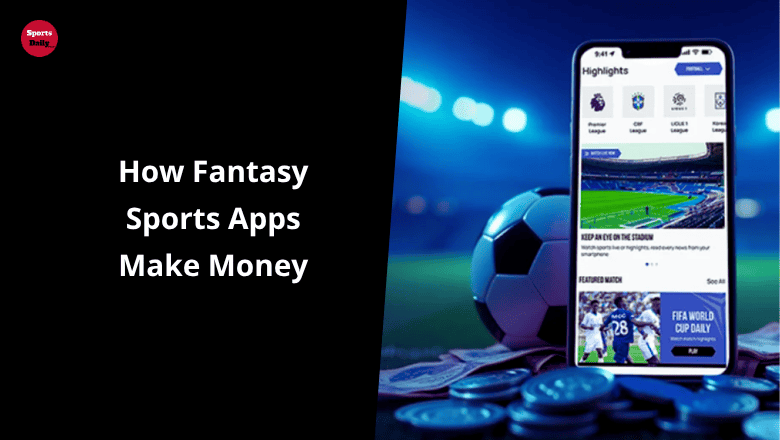
Fantasy sports have grown into a multi-billion dollar industry, with over 100 million active users worldwide. In 2025, the global fantasy sports market is expected to surpass $49 billion, driven by a passionate fanbase eager to participate in the action, not just watch it. This surge in popularity presents lucrative opportunities for businesses in the sports industry to expand engagement and generate revenue.
Fantasy sports apps generate income through a variety of channels, each tailored to specific aspects of the user experience. Whether through direct monetization like entry fees or more indirect methods like sponsorships and data analytics, these apps ensure they capitalize on every aspect of the gaming experience.
Primary Revenue Streams for Fantasy Sports Apps
1. Entry Fees and Commissions from Paid Contests
One of the most straightforward revenue streams for fantasy sports apps is the collection of entry fees for paid contests. Users pay a fee to join a contest or league, and the app takes a percentage of that fee, typically between 10% and 20%. The remaining portion forms the prize pool for the winners.
Why Entry Fees Work:
- Simplicity: It’s easy to understand for users, as they pay to play and know exactly what they’re competing for.
- Seasonal Revenue: Entry fees are a consistent source of income, especially during peak sports seasons.
2. Advertising and Sponsorships
In-app advertising and partnerships with sports brands, media outlets, or sports teams offer another major source of revenue for fantasy sports apps. These ads are often displayed during match days, offering targeted exposure to a highly engaged audience.
How Advertising Drives Revenue:
- Increased Visibility: Apps benefit from brand partnerships, as sponsors want to advertise to an audience actively participating in their sport of choice.
- Varied Formats: Ads can take the form of banners, video ads, or even branded content, offering flexible revenue options.
3. Premium Features and Subscriptions
Fantasy sports apps often offer premium subscription options that provide users with additional features, such as expert insights, advanced statistics, or ad-free experiences. Subscriptions can be a reliable, recurring source of income.
Why Premium Subscriptions Are Profitable:
- Loyalty: Users who pay for premium features are more likely to return, increasing engagement.
- Exclusive Content: Subscriptions offer unique advantages that enhance user experience, making them willing to pay for a better fantasy sports experience.
4. In-App Purchases
In-app purchases allow users to buy virtual items or features that improve their gaming experience. Examples include player boosts, enhanced scoring systems, and exclusive content.
How In-App Purchases Enhance Profitability:
- Microtransactions: Small, frequent purchases from users accumulate over time, leading to a steady revenue stream.
- Customization: Users enjoy personalized content, such as access to advanced statistics, improving their chances of winning.
Other Revenue Streams: Diversifying Income
While the primary revenue sources are essential, many fantasy sports apps find success through secondary streams that complement their main monetization methods.
5. Sports Betting and iGaming Integrations
As more regions legalize sports betting, many fantasy sports apps have integrated these services directly into their platforms. By offering betting options alongside fantasy games, these apps diversify their income.
Why Betting Integration Works:
- Cross-Platform Synergy: Betting naturally complements fantasy sports, as users who are already engaged in fantasy games may be inclined to place bets on real games.
- Big Margins: Sports betting offers significant revenue potential, as it involves real-time betting with high stakes.
6. Referral Programs
Referral programs allow existing users to invite friends to the platform in exchange for bonuses, free entries, or other rewards. These programs can significantly increase the app’s user base without heavy marketing costs.
How Referral Programs Contribute:
- Cost-Effective Growth: Instead of spending money on advertising, apps tap into their existing user base to generate new sign-ups.
- Engaged Users: Users who refer others are often more committed and loyal, increasing overall engagement.
7. Data and Analytics
Fantasy sports apps generate a wealth of user data, which can be monetized in several ways. This data can be used internally to improve app features or sold to third-party marketers and sports teams looking for consumer insights.
Data Insights as a Revenue Source:
- Market Research: The insights from user behavior and preferences can be highly valuable to brands, creating a new avenue for revenue generation.
- Customization: Apps can also use data to personalize user experiences, encouraging users to engage more deeply with the platform.
The Future of Fantasy Sports App Monetization: Trends for 2025
As the fantasy sports landscape evolves, new technologies and trends are beginning to shape how these apps make money. The rise of AI, blockchain, and NFTs will likely redefine the future of monetization.
Blockchain and NFTs
In 2025, many fantasy sports apps are incorporating blockchain technology to enhance transparency, prevent fraud, and offer immutable transaction records. NFTs (non-fungible tokens) are also being used to offer exclusive player cards or collectibles as rewards, adding another layer to the gaming experience.
AI-Powered Recommendations
Artificial intelligence is making fantasy sports apps smarter. By analyzing player performance data, AI can suggest optimal picks, trades, and strategies to users, creating a more immersive experience that encourages users to invest in premium features.
Cross-Platform Compatibility
As the market grows, having a seamless user experience across multiple platforms (iOS, Android, web) becomes essential. Fantasy sports apps will need to ensure compatibility to cater to their audience wherever they are.
The Cost to Build a Fantasy Sports App in 2025
Building a fantasy sports app comes with a price tag, which varies depending on the features, complexity, and platform. Below is an outline of the cost breakdown for developing a fantasy sports app in 2025.
1. Minimal Viable Product (MVP)
A basic fantasy sports app that includes essential features such as team creation, leaderboards, and simple scoring systems.
- Cost Range: $20,000 – $35,000
- Timeline: 2–3 months
2. Standard Fantasy App
A more advanced app that includes live score updates, real-time integrations, and a robust admin panel.
- Cost Range: $40,000 – $80,000
- Timeline: 3–5 months
3. Advanced Fantasy App with Blockchain and NFTs
For cutting-edge platforms with AI-powered features, blockchain integration, and NFT capabilities.
- Cost Range: $80,000 – $120,000+
- Timeline: 5–8 months
Conclusion: The Future of Fantasy Sports App Monetization
The fantasy sports industry is set to continue its rapid growth, and understanding how these apps make money is crucial for any sports management company or developer. By diversifying revenue streams—such as through entry fees, advertising, and in-app purchases—fantasy sports apps can create a sustainable business model. As we look toward 2025, emerging technologies like blockchain and AI will further shape the monetization landscape, opening up new opportunities for innovation and profitability.
 Sports Daily Info All Things Sports, from News to Match Schedules
Sports Daily Info All Things Sports, from News to Match Schedules

